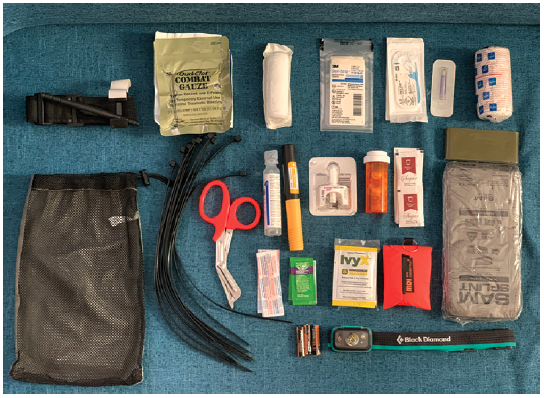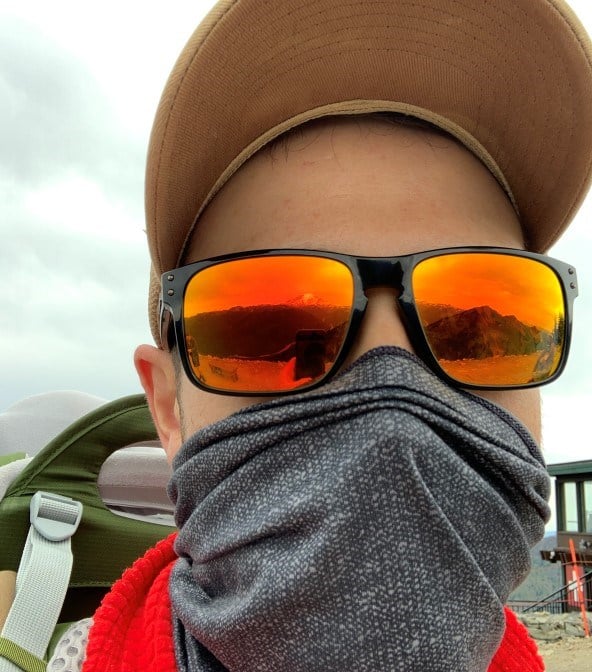In April 2020, the EMRA Wilderness Committee recognized COVID-19 as a barrier to wilderness exploration and reached out to the wilderness medicine community via Zoom for solutions.
Guest speakers Paul Auerbach, MD, MS, FACEP; Timothy Erickson, MD, FACEP; Taylor Haston, DO, FACEP; and Ian Wedmore, MD, FACEP, joined us to contribute their insights on staying mentally well and physically healthy amid the variable dangers of COVID-19.
How can you safely get outdoors? What do you need to plan to stay safe? How can you spend time in the wilderness responsibly? What impact can you have on the health of our planet and its future after COVID-19? In this article, we review the most up-to-date, expert recommendations for these questions in order to get you safely into the wild.
Getting Outdoors
As with any great trip, start by doing your homework. When it comes to your destination, consider the latest local regulations on travel. Avoid going too far in order to avoid potentially spreading the virus. Given the current state of international travel, you may have to delay or cancel a trip you have already planned. In the U.S., the Centers for Disease Control and Prevention website offers the latest information on COVID-19 spread.1 Popular activities like thru-hiking and visiting national or state parks may be restricted due to limited services or closures.2 Instead of driving long distances or flying, consider biking to a trailhead, exploring a local park that is within walking distance, or checking out nearby forest lands that are less well-known. Be flexible. Your local area likely has many options you may not have considered before; take it on as a new adventure.
Staying Safe
Before embarking solo, there are a few things to consider to ensure your safety as well as that of others. As with any outdoor activity, check the weather forecast. The National Oceanic and Atmospheric Administration (NOAA) has in-depth reports even for remote locations.3 Be sure to let others know where you are going and when to expect your return. Review the route, read updates regarding trail conditions, and, most importantly, be realistic about your skill level and do not try to exceed it while alone. Emergency Medical Services (EMS) and rescue teams are already taxed and may not be able to reach you in a timely manner.4 Many hospitals are struggling with capacity and not performing elective surgeries, so now is not the time to push your limits on a solo mission.
To keep everyone healthy, don't forget about social distancing. Stay at least 6 feet away from others, and wear a mask and glasses combination that covers your nose, mouth, and eyes (given both the CDC and the European Centre for Disease Prevention and Control's concern for airborne qualities of SARS-CoV-2).5,6 Consider a cotton mask or neck buff that you can put on quickly as an acceptable solution when you are on a less busy trail. Many outdoor clothing companies are manufacturing face coverings and supporting local businesses when possible is a great option. Try to travel at non-peak hours to steer clear of crowds. Avoid trailheads with busy parking lots and find less common access points where possible. Do not leave your house without hand sanitizer as water for handwashing may be limited. Consider bringing biodegradable soap if there is water access along your route, and wash your hands for 20 seconds (remember the birthday song?).7 Most importantly, do not touch your face.
When packing your bag for an adventure, bring sufficient food, water, layers of clothing, sun protection, good shoes, extra socks, and a first aid kit. Some key components for a first aid kit include: blister prevention (moleskin, antibiotic ointment, bandages), a multi-tool/Swiss army knife, headlamp, duct tape, scissors, a tourniquet, and basic medications (see Image 2 for a sample first aid kit, courtesy of the EMRA Wilderness Committee Chair Yev Maksimenko).

Bring your prescription medications, including your as-needed ones, such as an albuterol inhaler or an Epi-Pen. Depending on the activity, make sure you have appropriate gear for your adventure. And don't forget the 10 essentials (check out REI's list if you haven't heard of this).8
Recreating Responsibly9
While on your adventure, "recreating responsibly" means not only respecting fellow humans but also the environment and nature. During our conference, we discussed how to prevent the spread of disease, but equally important is making a priority of protecting wilderness spaces.
Given travel restrictions and stay-at-home orders, we can do a lot for the health of the planet by further reducing travel by air and car. We are already seeing short-term improvements in air quality around the world as a result of reduced manufacturing and travel, particularly China, where air pollution has significantly improved compared to prior years.10 On the other hand, the lack of international and domestic tourism is causing world-renowned natural reservations to suffer financially, and as a result, is putting many endangered animals and their protection in jeopardy.11 Maybe now is the time to explore a better alternative for our planet; consider the human impact on its precious natural resources and animals around the world. This change can start with you.
We can begin by keeping our natural lands free of human interference, locally and while on the trail. One easy thing to do is to "leave no trace," (don't litter). Pack in and out all trash as the ever-reliable trailhead trash bin may no longer be regularly emptied. On the trail, avoid heavily muddied sections, which are prone to erosion, as maintenance crews may be limited or not working. When possible, consider volunteering to maintain trails. Moreover, consider supporting local businesses in your area prior to traveling by purchasing snacks and supplies at nearby stores. This will help avoid draining small-town businesses that are supplying the local population and minimize potential health risks to you and the communities you enter. Finally, remember to advocate for the outdoors and to be inclusive of all identities and abilities; this planet belongs to all of us.
What Else Can I Do? Gain Knowledge
Not sure if this is the time to get outside? Forced to stay inside by quarantine orders? Now can also be an opportune time to work towards your Fellow of the Academy of Wilderness Medicine (FAWM). Our friends at the Wilderness Medical Society12 made it easy for you to start earning credits.
Take advantage of virtual conferences where you can learn new skills and earn credits towards the FAWM. This is a great opportunity to maximize your continuing medical education (CME) funds. Not sure where to get started? Reach out to the EMRA Wilderness Committee leadership.
Not for you? Consider some other ideas, such as hosting Zoom meetings with other wilderness groups (around the world, if you wish) to trade stories and trail recommendations. Challenge your wilderness practical skills, such as navigation with a compass (without GPS), packing lightweight gear, or tying knots. Take the time to inspect your gear. Set up your tent and check it for holes or broken poles. Fix old gear and sort through your closet for donations. You can donate gently-used gear to a non-profit organization. There are many programs, i.e. those for underserved and at-risk youth, that depend on donations to allow continued access to the outdoors. On the homefront, grab a trash bag and clean up a park or trail. And try to support local businesses when shopping for new gear.
Ultimately, remember: wear a mask, wash your hands, keep your distance, dream up your next adventure, and stay positive. We will get through this together.
References
- “Cases in the U.S.” Centers for Disease Control and Prevention, Centers for Disease Control and Prevention, 9 July 2020, www.cdc.gov/coronavirus/2019-ncov/cases-updates/cases-in-us.html.
- “Southern Terminus Shuttle.” Continental Divide Trail Coalition, continentaldividetrail.org/southern-terminus-shuttle/.
- National Oceanic and Atmospheric Administration, www.noaa.gov.
- Howard, M. (2020, June 25). Flood of hikers, protective gear requirements could pose challenges for search-and-rescue teams. Retrieved July 30, 2020, from https://www.washingtonpost.com/lifestyle/travel/flood-of-hikers-protective-gear-requirements-could-pose-challenges-for-search-and-rescue-teams/2020/06/25/3a647ddc-b1b4-11ea-856d-5054296735e5_story.html
- Interim Infection Prevention and Control Recommendations for Patients with Suspected or Confirmed Coronavirus Disease 2019 (COVID-19) in Healthcare Settings. https://www.cdc.gov/coronavirus/2019-ncov/infection-control/control-recommendations.html
- Infection prevention and control for COVID-19 in healthcare settings. https://www.ecdc.europa.eu/en/publications-data/infection-prevention-and-control-covid-19-healthcare-settings
- NOLS. “Social Distancing Responsibly in the Outdoors.” NOLS Blog, 19 Mar. 2020, blog.nols.edu/2020/03/19/social-distancing-responsibly-outdoors.
- Bible, Aaron. “10 Essentials Every Hiker Should Always Carry.” REI Co-Op Journal, REI, 18 Aug. 2017, www.rei.com/blog/hike/10-essentials-every-hiker-always-carry
- “How to Recreate Responsibly.” REI, https://www.rei.com/blog/news/recreate-responsibly.
- He, G., Pan, Y., & Tanaka, T. (2020, July 07). The short-term impacts of COVID-19 lockdown on urban air pollution in China. Retrieved July 20, 2020, from https://www.nature.com/articles/s41893-020-0581-y
- Sunkara, L. (2020, July 08). Protecting African Wildlife During COVID-19: How Wilderness Safaris Is Taking Action. Retrieved July 21, 2020, from https://www.forbes.com/sites/lavanyasunkara/2020/07/09/protecting-african-wildlife-during-covid-19-how-wilderness-safaris-is-taking-action/
- Various. “COVID-19 and Wilderness Medicine.” Wilderness Medical Society, 2 July 2020, wms.org/magazine/1259/covid-19-updates.



